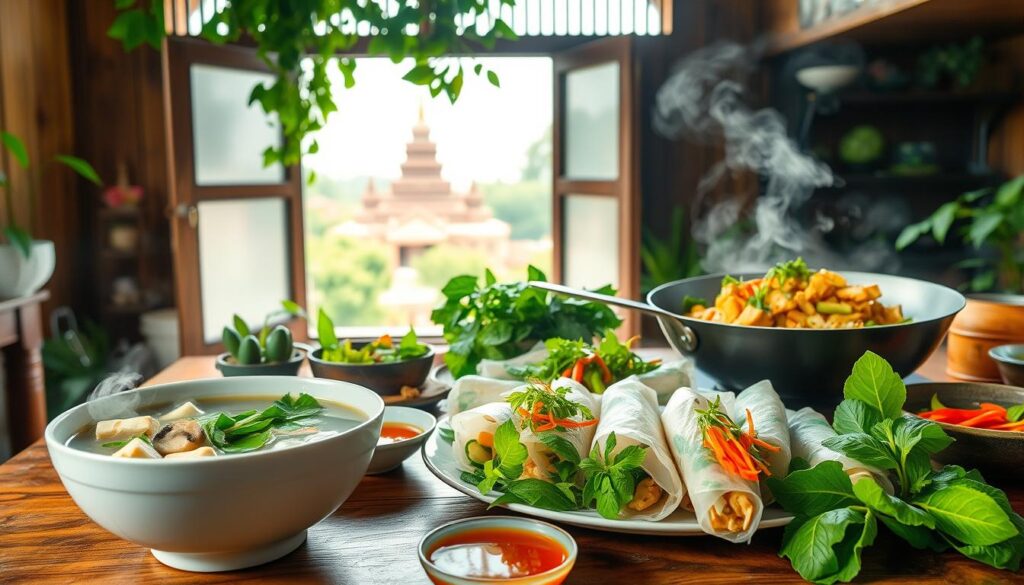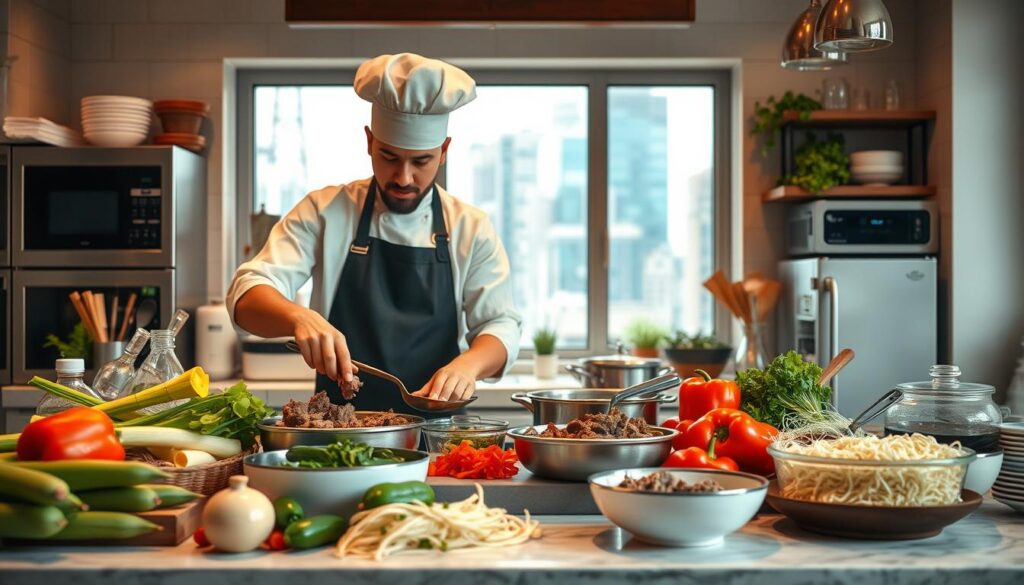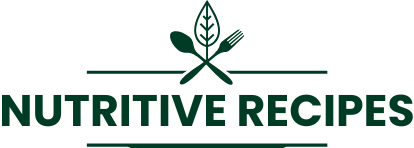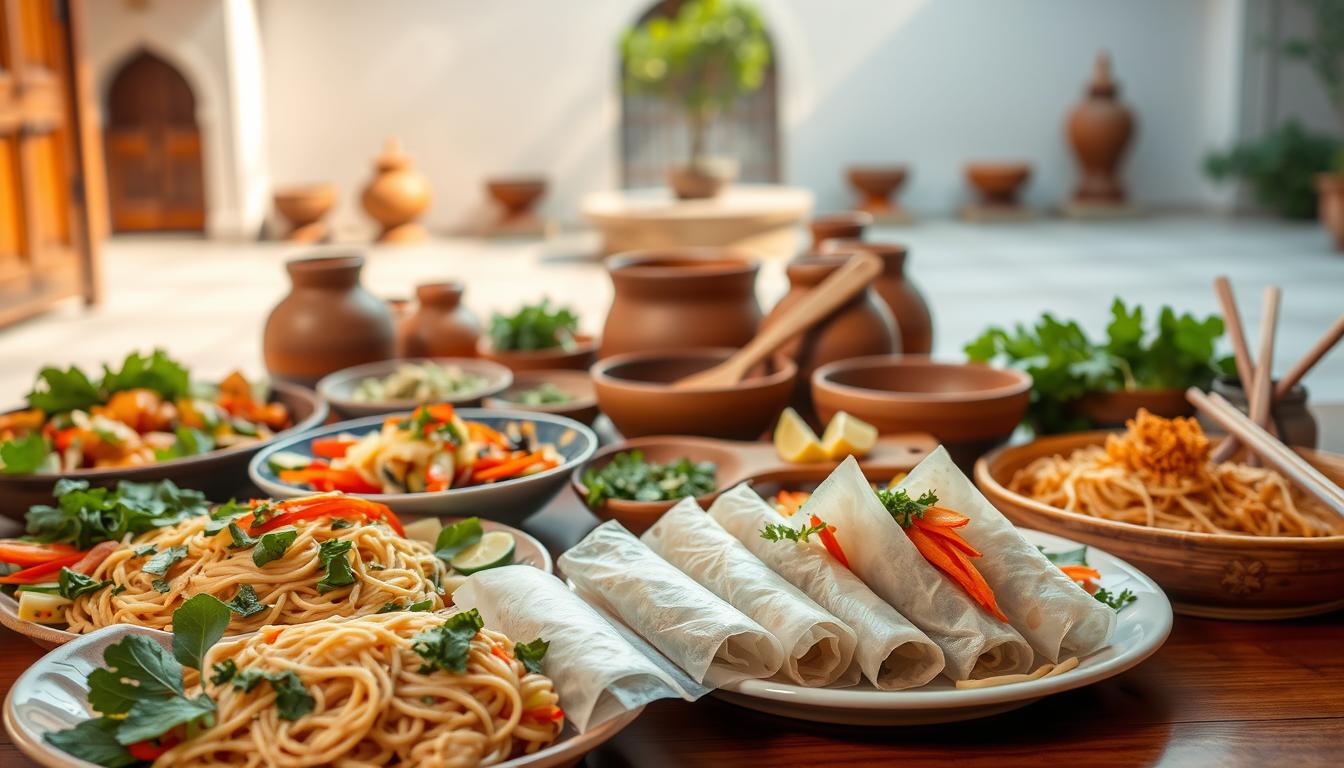Table of Contents
When I first found Vietnamese Buddhist cuisine, it was more than food. It was a journey back to my roots. My grandmother’s cooking was like a quiet prayer. Each dish, like a steamed vegetable roll or a fragrant pho, was filled with mindfulness.
These flavors opened my eyes to how food can heal both body and spirit. Today, I want to share recipes that have been passed down for centuries. These dishes are not just meals; they’re a way to find balance and nourishment.
Whether you’re into plant-based eating or want to connect more with your food, this guide is for you. It shows how these ancient practices can change your kitchen and your health.
Key Takeaways
- Discover plant-based dishes that blend tradition with modern wellness.
- Learn how buddhist cuisine principles promote mindful eating and digestion.
- Find easy swaps to adapt vietnamese recipes buddhist to your pantry.
- Understand the link between Vietnamese temple cooking and holistic health.
- Enjoy vibrant, flavorful meals without sacrificing taste or tradition.
The Philosophy Behind Vietnamese Buddhist Cuisine
Exploring buddhist cuisine opened my eyes to a spiritual way of eating. It’s all about making meals that are good for you and the planet. The Five Precepts guide these choices, focusing on life and sustainability.
The Five Precepts and Their Influence on Food
The first precept, non-violence, means we avoid harming animals and the environment. This leads to dishes like jackfruit “pulled pork” or tofu soups. Here’s how these principles shape our meals:
- No animal products show respect for life.
- Using seasonal, local ingredients helps the planet.
- Simple cooking lets nature’s flavors shine.
Mindfulness in Food Preparation
Cooking becomes a meditation. I learned to chop vegetables slowly and savor each step. It’s like a prayer, connecting us to our food and each other.
The Balance of Flavors and Nutrients
In healthy vietnamese cooking, every dish has a balance of tastes: sweet, sour, bitter, salty, and spicy. This balance mirrors life itself. For example, a simple salad might mix roasted peanuts, lime, and chili for a nourishing meal.
Learning these principles can inspire us to cook with intention. For more tips, visit Nutritive Recipes for mindful kitchen practices.
Essential Ingredients in Vietnamese Buddhist Cooking
Starting a pantry for traditional vietnamese dishes means getting these key items. I’ve found them in local Asian markets and some big stores. Here’s what you need in your kitchen:
- Mushroom powder: A flavor base without MSG, found in temple recipes. Lee Kum Kee is great for soups and stir-fries.
- Tofu and seitan: These are the main proteins in vietnamese vegetarian dishes. Nasoya’s firm tofu and Field Roast seitan are perfect for stews.
- Tempeh and rice paper: Use tempeh from South River Farms for salads, and Oriental Foods rice paper for spring rolls.
- Herbs and spices: Cilantro, Thai basil, and lemongrass add freshness. Keep them fresh in a jar or freeze for quick meals.
For storage, keep dried mushrooms in airtight jars and freeze herbs in ice cube trays. These ingredients are more than flavor—they’re the heart of mindful cooking. When I started, I shopped at H Mart and 99 Ranch. Now, even Whole Foods has brands like 365 Everyday Value mushroom powder. Each spice and bean here has a story of centuries-old traditions, made easy for today’s kitchens.
Vietnamese Recipes Buddhist Monks Have Perfected Over Centuries
In temple kitchens across Vietnam, I saw how monks make meals that are both healthy and spiritual. These vietnamese temple recipes show centuries of careful cooking. They mix tradition with health, making each dish a story of patience and respect for food.
Temple-Style Cooking Techniques
Monks focus on every detail. For example, vietnamese recipes buddhist often simmer vegetables slowly to bring out their flavor. They slice herbs and vegetables thinly to add texture. This way, every bite is full of natural taste without needing lots of seasonings. A monk in Hanoi said:
“Every cut and simmer is a meditation. We honor ingredients by preparing them with intention.”
Seasonal Considerations in Buddhist Meals
Temples change their menus with the seasons. In spring, they use fresh bamboo shoots in soups. Autumn brings stews with root vegetables. This follows the idea of living in harmony with nature. Monks believe that eating with the seasons is best for our bodies.
Regional Variations Across Vietnam
- North Vietnam: Simple dishes like vietnamese temple recipes use mushrooms and soy for flavor.
- Central Vietnam: Spicy dishes with lemongrass and chilies are common, even in temples.
- South Vietnam: Tropical fruits like jackfruit sweeten curries and soups.
Looking at these differences shows how place shapes spiritual food. Each area’s vietnamese recipes buddhist offers a special way to eat mindfully.
My Journey Into Plant-Based Vietnamese Cuisine
My first taste of temple tofu soup in Hue changed me. The flavors were rich yet simple, showing that vegetarian Vietnamese recipes can be both healthy and heartwarming. This experience sparked a journey to learn dishes that mix old traditions with today’s cooking.
How I Discovered Buddhist Temple Recipes
At Pho Bang Pagoda, monks taught me that every ingredient has a story. They said, “Cook with gratitude, not just heat.” I learned about slow-cooking broths and finding wild herbs, key to my plant-based recipes. Finding pho leaves in the U.S. was hard, but I found substitutes like dried kelp and lemongrass.
“The kitchen is a temple where patience becomes perfection.” — Elder Monk Thích Pháp Tạng
Transformative Power of Mindful Cooking
Letting go of the idea that vegetarian food is bland was crucial. Here’s what changed:
- Discovering umami from mushrooms instead of meat broths
- Exploring texture contrasts (crispy spring rolls vs. soft rice noodles)
- Using star anise and fish sauce alternatives like shrimp paste-free versions
| Traditional Ingredient | American Kitchen Substitute |
|---|---|
| Fresh rice paper | Store-bought rounds or crepe-like alternatives |
| Wild forest mushrooms | Hybrid mix of oyster, shiitake, and cremini |
| Palm sugar | Coconut sugar + lime zest for brightness |
These changes kept the dishes true to their roots but easy to make today. Now, I share this knowledge with others. I show them how vegetarian Vietnamese recipes connect us to our heritage and improve our health.
Nourishing Breakfast Recipes From Vietnamese Temples
Temple kitchens in Vietnam offer breakfasts that boost energy and soothe the mind. My top vietnamese recipes buddhist include cháo, a comforting rice porridge. I make it with wood ear mushrooms and Thai basil for a creamy taste. It’s a simple yet fulfilling dish.
Buddhist monks focus on balance in their meals. My healthy vietnamese cooking version of cháo adds coconut milk for creaminess and turmeric for health benefits. Serve it with pickled carrots and daikon for a burst of flavor. Another favorite is bánh mì chay, a meatless version of the classic baguette. It’s filled with marinated tofu, pickled veggies, and fresh herbs, making it a tasty, portable meal.
- Cháo: Cook jasmine rice with water and mushrooms until thick
- Xôi gấc: Steamed sticky rice dyed red with gấc fruit, served with coconut cream
- Bánh mì chay: Tofu patty, cilantro, and housemade chili sauce in a crisp baguette
These dishes are more than just food—they’re mindful practices. Monks eat slowly, enjoying each bite to stay in the moment. When I make xôi gấc, I focus on its vibrant color and earthy taste, turning cooking into meditation. Use local ingredients like beetroot to make a similar dish. Start your day with these temple-inspired meals to feel nourished and grounded.
Hearty Lunch and Dinner Vegetarian Vietnamese Dishes

Creating vegetarian vietnamese recipes means making dishes that are filling but still true to tradition. I learned from Buddhist monks how to turn simple foods into meals that feed both body and soul. These meat-free vietnamese meals show that plant-based food can be both hearty and full of flavor.
Mock Meat Alternatives in Traditional Recipes
- Wheat gluten: Soaked seitan acts like chicken in ga kho tau, a caramelized “chicken” stir-fry.
- Wood ear mushrooms: Rehydrated mushrooms add a chewy texture to soups and stir-fries.
- Tofu: Silken tofu makes smooth dips, while firm tofu becomes crispy “fish” cakes.
Protein-Rich Plant-Based Main Courses
Tempeh pho is a modern take, featuring marinated tempeh in traditional pho broth. My top pick? Lemongrass “chicken”—seitan marinated in lemongrass, fish sauce, and star anise. Pair it with jasmine rice for a meal full of protein.
One-Bowl Balanced Meals
For a quick meal, mix rice noodles, blanched veggies, and marinated tofu for a com tam chay bowl. Add fresh herbs and chili-lime dressing for a burst of flavor. These bowls are perfect for busy nights—they’re fast but feel like a feast.
Adopting meat-free vietnamese meals showed me that simplicity can lead to creativity. Every bite of these dishes proves that plant-based doesn’t mean boring—it opens up a world of new flavors.
Health Benefits of Traditional Vietnamese Buddhist Diets
Exploring healthy vietnamese cooking showed me how it matches today’s health goals. These dishes are low in oil and high in fresh herbs. This makes them full of vitamins and fiber.
Studies confirm that turmeric in our soups fights inflammation. Ginger helps with digestion. This shows that old traditions and new science agree.
Research from the Journal of Nutrition highlights turmeric’s curcumin as a powerful anti-inflammatory compound.
Ingredients like lemongrass, mushrooms, and jackfruit are packed with antioxidants and protein. My favorite plant-based recipes include:
- Turmeric for anti-inflammatory benefits
- Lemongrass to support digestion
- Shiitake mushrooms for immune-boosting beta-glucans
| Ingredient | Key Nutrient | Example Use |
|---|---|---|
| Turmeric | Curcumin | In golden milk or broth |
| Lemongrass | Vitamin C | Chicken-free pho base |
| Jackfruit | Fiber | Mock meat dishes |
Plant-based recipes solve many health issues. Rice and beans together make complete protein. Nori sheets in spring rolls add iodine. Switching to these light, nutrient-rich meals boosted my energy.
Vietnamese Buddhist cooking is more than spiritual. It’s backed by science, nourishing both body and mind.
Adapting Buddhist Recipes for American Kitchens

Bringing vietnamese vegetarian dishes into U.S. kitchens doesn’t mean sacrificing tradition. Here’s how to adapt without losing flavor or meaning:
Ingredient Substitutions You Can Find Locally
- Swap rau răm (Vietnamese coriander) with cilantro for fresh crunch
- Use shiitake mushrooms in place of rare nấm mối (ant fungus)
- Replace fish sauce with soy sauce or mushroom-based umami pastes
Time-Saving Techniques for Busy Schedules
- Batch-cook broth in slow cookers for 6-8 hours overnight
- Pre-chop vegetables and freeze for traditional vietnamese dishes like goi cuon (spring rolls)
- Use pre-soaked grains like jasmine rice for instant pots
| Traditional Method | Adapted Method |
|---|---|
| Hand-pounding mortar & pestle | Small food processor for pesto-like pastes |
| 4-hour simmered broths | Pressure cooker 30-minute shortcut |
“I never thought I’d make vietnamese vegetarian dishes in Chicago until I tried swapping local greens,” said a student in my Austin class.
Maintaining authenticity means keeping core principles: balance in flavors, reverence for ingredients, and mindful preparation. My workshops show that even with substitutions, dishes retain their soul. Explore Nutritive Recipes’ guides for substitution charts and prep tips. Small tweaks let you honor tradition while making these recipes your own.
Celebrating Special Occasions With Buddhist Feast Recipes
When Lunar New Year or temple festivals come, vietnamese temple recipes turn into colorful feasts. These vietnamese vegetarian dishes are more than food—they’re acts of devotion. I’ve seen mock meat “roasts” and fruit sculptures impress even meat lovers.
| Dish | Key Technique | Cultural Meaning |
|---|---|---|
| Bánh chưng chay | Layered sticky rice with beans and banana leaves | Symbols of earth’s fertility in Tet celebrations |
| Vegetable “duck” roast | Portobello mushrooms stuffed with tofu | Represents abundance in temple offerings |
| Lotus flower salad | Shredded papaya with coconut dressing | Emulates purity in monastic traditions |
My secret? Use jackfruit for mock meats—it stays tender when slow-cooked. For holidays like Thanksgiving, try chrysanthemum-shaped rice flour cakes instead of pies. Always serve dishes in odd numbers, like three or five, as even numbers are for casual meals.
- Carve starfruit into floral shapes for table centerpieces
- Pair bitter melon dishes with sweet coconut milk sauces
- Light incense before serving as a nod to tradition
These feasts are more than just food—they connect our heritage with today’s life. By learning a few vietnamese temple recipes, you can make any dinner a celebration of mindfulness and joy.
Conclusion: Embracing the Path to Wellness Through Vietnamese Buddhist Cooking
Learning about vietnamese recipes buddhist showed me that food is more than just fuel. It connects us to tradition, nature, and self-care. These meat-free vietnamese meals are not just food; they’re a way to slow down and enjoy each bite. They honor the planet and our well-being.
Every dish I’ve made, from stir-fries to soups, reflects centuries of mindful cooking. It combines flavors like turmeric, lemongrass, and fresh herbs. This blend nourishes both our bodies and spirits.
My kitchen experiments have shown how these recipes reduce stress and increase gratitude. Even small changes, like using tofu instead of meat or seasonal veggies, make a big difference. Simple dishes like pho chay or vegetable spring rolls show how easy it is to align our meals with compassion and balance.
You don’t have to be a master chef right away. Start with simple dishes like a morning chia seed pudding or a stir-fry with what you have. Let cooking be a daily meditation. Chop vegetables with care, taste as you go, and share meals with those you love. Over time, your view of food will change.
Remember, vietnamese recipes buddhist are not about being perfect. They’re about being present. Whether it’s a quiet dinner or a big gathering, the key is respect for life, harmony in flavors, and joy in cooking. Your kitchen is a place for growth, one dish at a time.

